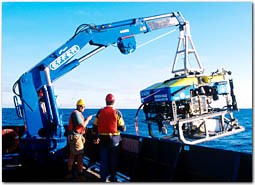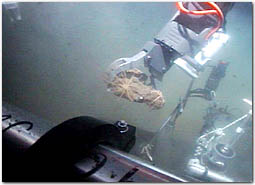
|
 |
Science Highlights > The New Jason: Better, Faster; Deeper
The New Jason: Better, Faster, Deeper
 |

Click to enlarge
|
|
Two manipulators on the new Jason can maneuver payloads of up to 150 pounds (330 kilograms). (Photo by Dan Fornari) |
A decade ago, WHOI Research Specialist Andy Bowen and colleagues struggled to persuade scientists that remotely operated vehicles (ROVs)-deep-sea robots tethered to a cable carrying power and data-were valuable tools for observing and sampling the seafloor, not just novelties.
Three-dozen expeditions later, oceanographers don’t argue over whether to use Jason. They compete for research time using it. “It is rewarding to see the enthusiasm of the scientists working with this vehicle,” said Bowen, project manager for the new Jason. The second-generation ROV was unveiled in 2002 by the WHOI Deep Submergence Laboratory and the National Deep Submergence Facility.
The new ROV uses high-bandwidth, digital communications systems and state-of-the-art robotics to allow scientists to observe and sample the seafloor without leaving the deck of a ship. The new Jason has two manipulator arms (above left), which can reach twice as far and lift five times as much as the single arm on the original vehicle (above, left). A more robust design allows the new Jason to dive to 6,500 meters (21,320 feet), compared with 6,000 meters (19,680 feet) for the original, while carrying more equipment, gathering more samples, and supplying more power to the instruments. It can do all of this moving at twice the speed of its predecessor.

Click to enlarge
|
 |
|
On its first mission, the new Jason vehicle operated nearly 300 hours without a failure. The UK’s Southampton Oceanography Centre has enlisted WHOI to build a Jason copy, called Isis.
|
In September 2002, the new Jason completed its first science mission, diving to the Juan de Fuca Ridge off Oregon. Researchers led by University of Washington oceanographer Paul Johnson used the ROV to deploy and retrieve several experiments to study microbes living within oceanic crust. “ROVs have a reputation of taking one or two years to be fully operational,” Johnson said. “The new Jason worked well right out of the box. In my view it doesn’t get any better than this.”
How important has the new Jason become to the US oceanographic community? It is already booked into 2004.
Development and construction of the new
Jason were funded by the National Science Foundation, the W. M. Keck Foundation, and WHOI.
|
|
